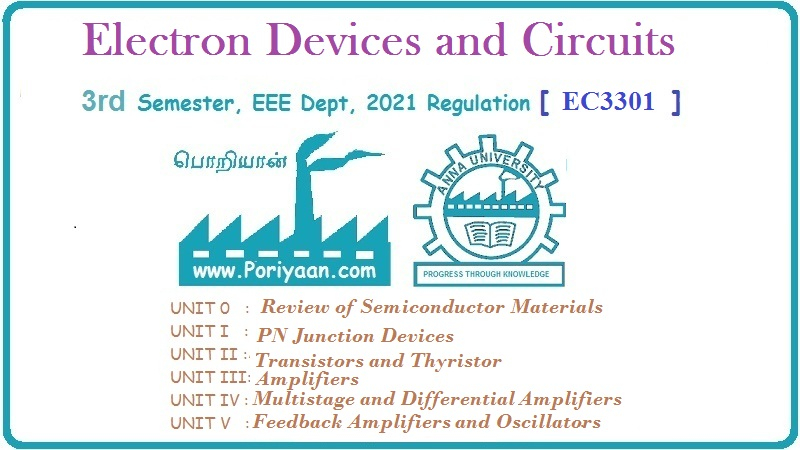Electron Devices and Circuits: Unit III: (a) BJT Amplifiers
Two Marks Questions with Answers
BJT Amplifiers | Electron Devices and Circuits
Electron Devices and Circuits: Unit III: (a) BJT Amplifiers : Two Marks Questions with Answers
Two Marks Questions with Answers
Q.
1 Draw the hybrid small signal model of common base configuration. (Refer Fig.
6.3.4)
AU
: Dec.-02, Dec.-05, Dec.-06
Q.
2 What are hybrid parameters ?
(Refer
section 6.2)
Q.
3 Draw the low frequency hybrid model of BJT in common emitter configuration.
(Refer
Fig. 6.3.4)
Q.
4 Define the hle and hfe for a common emitter transistor configuration.
(Refer
section 6.3.2)
Q.
5 Draw the hybrid model of a CE transistor.
(Refer
section 6.3.2)
Q.
6 What are the steps used for small signal analysis of BJT ?
(Refer
section 6.5)
Q.
7 Give the current gain expression for a common emitter transistor
configuration.

Q.
8 Define the four h-parameters.
(Refer
section 6.2)
Q.
9 State Miller’s theorem.
AU
: ECE : May-04, 08, 12, Dec.-06, 07, 16
Ans.
:
Miller's theorem states that, if Z is the impedance connected between two
nodes, node 1 and node 2, it can be replaced by two separate impedances Z1
andZ2; where Z1 is connected between node 1 and ground and Z2 is connected
between node 2 and ground. The V; and Vo are the voltages at the node 1 and
node 2 respectively. The values of Z1 andZ2 can be derived from the ratio of Vo
and V; (Vo / V;), denoted as K. Thus it is not necessary to know the values of
V; and Vo to calculate the values of Z1 and Z 2.
The
values of impedances Z1 andZ2 are given as
Z1
= Z / 1 – K and Z2 = Z. K / K - 1
Q.10
Define the uarious h-parameters for a common emitter transistor.
(Refer
section 6.3.2)
Q.11
What do you mean by faithful amplification ?
Ans.
:
During the process of raising the strength of the input signal if the shape of
the output voltage is exactly same as that of the input signal, the
amplification is called faithful amplification.
Q.12
State the advantages of using h-parameters for analyzing transistor amplifiers.
(Refer
section 6.3.1)
Q.13
Give the voltage gain for CE configuration including source resistance.

Q.14
Draw general frequency response curve of an amplifier. AU : ECE : Dec.-07
(Refer Fig. 6.9.1 (b))
Q.15
What is the significance of octaves and decades in frequency response ?
AU
: ECE : Dec.-06
(Refer
section 6.9)
Q.16
What is bandwidth of an amplifier ?
AU
: May-07, Dec.-08, 09, May-09
Ans.
:
The bandwidth of the amplifier is defined as the difference between the lower
cut-off frequency and the upper cut-off frequency.
BW
= f2 - f1
Q.17
What is roll-off ?
(Refer
section 6.9)
Q.18
What do you mean by half-power frequencies ?
(Refer
section 6.9)
Q.19
State the effect of coupling and bypass capacitors on the frequency response of
amplifier.
(Refer
section 6.9.1)
Q.20
State the effect of internal transistor capacitances on the frequency response
of amplifier.
(Refer
section 6.9.1.3)
Q.21
Define the four h-parameters.
(Refer
section 6.3.2)
Q.22
Draw the hybrid model of BJT in CE configuration.
(Refer
section 6.3.3)
Q.23
What is the need of coupling capacitors in amplifier design? AU : Dec.-15
(Refer
section 6.1.1)
Q.24
Draw the small signal model of BJT device.
[Refer
Fig. 6.4.2]
Q.25
Draw the hybrid small signal model of CB configuration.
[Refer
Fig. 6.3.4]
Q.26
State the phase relationships between input/output currents and between
input/output voltages of uarious transistor configurations.
(Refer
section 6.1.4)
Electron Devices and Circuits: Unit III: (a) BJT Amplifiers : Tag: : BJT Amplifiers | Electron Devices and Circuits - Two Marks Questions with Answers
Related Topics
Related Subjects
Electron Devices and Circuits
EC3301 3rd Semester EEE Dept | 2021 Regulation | 3rd Semester EEE Dept 2021 Regulation
